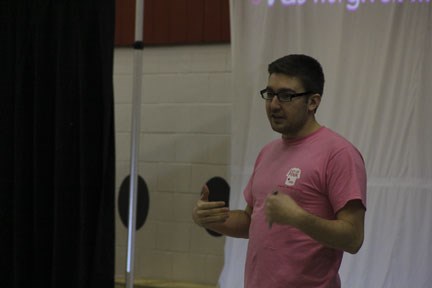Following Pink Shirt Day, the founder of the anti-bullying movement came to Estevan to present his message of respect and renewal.
Travis Price was in Grade 12 when he and a friend of his sought to show a Grade 9 peer he wasn't alone in their high school by wearing pink shirts and encouraging the rest of the school to wear pink in solidarity with the student. Since that day in Nova Scotia in 2007, pink shirts have become a symbol for the youth movement to advocate the unacceptability of bullying.
Last year, six million people participated in Pink Shirt Day in 13 different countries. This October, Price is travelling to Tokyo to speak and share his message.
Price attended Sacred Heart/Sacré Coeur School in the afternoon April 10, speaking to students in the gymnasium about his experiences with bullies.
"To me it's the repetitiveness of it," Price said about what constitutes bullying. "It's taking advantage of a kid or student or even a worker in a vulnerable situation and repetitively attacking that one thing. You see these politicians who say 'you're bullying me,' and that's kind of what they're signing up for. What they're going through is not what a 17-year-old girl who has been sexually assaulted and is now being slut-shamed (is going through). That's not the same thing. I look for the repetitiveness of it, and I look for who's doing it. Is it a student with more power? That's what defines bullying to me."
When these issues involve young people, he said it's difficult for people to use words like harassment or assault, so the default people turn to is bullying, which in some ways then becomes all encompassing.
"It's hard to identify, but with government regulation and with the Red Cross programs, it helps define what bullying is."
Price was bullied for the majority of his school life, beginning in first grade and enduring a steady dose of the behaviour into Grade 12. Some days it was worse than others, and each year growing up was different. He said early on he didn't identify his peers' behaviour as bullying, something difficult for a six-year-old to understand. It was particularly difficult in Grades 7, 9 and 10.
In Grade 7, after an incident with a guy and two girls, he dragged himself home, collapsing in his room, only to wake up in the hospital later with five broken ribs and a broken ankle.
He had been knocked down and kicked repeatedly in the stomach. The attack stopped only when one of the participants said, "This is boring. Let's do something else."
After that, he didn't go to school for two months.
"I never wanted to go to school again. I didn't feel safe," he told the Estevan students, knowing that he would only be ridiculed for the attack that left him broken. "We should want to go to school. We should want to learn. We should want to make friends."
But Price didn't want to do any of those things.
He found release in music, video games and sports, playing volleyball, which he played for three years in university. Even when it came to sports, those who bullied him called it a "girls" sport.
But it didn't matter when he was on the court. Volleyball allowed him to focus, providing an outlet where he could take his mind off his troubles outside. When he jumped in the air preparing to spike a volley, he said he wasn't thinking about being bullied. He could focus on where he would hit the ball and then where he would have to be the moment he was finished with his shot.
Entering Grade 12, he said rumours rippled through his school one day that a Grade 9 boy on his first day at the school was wearing a pink shirt and was suddenly the butt of jokes and ridicule. Some students were eyeing an appropriate time to beat him up.
Price said when he first heard the news, he shrugged it off, a bit relieved that the group was at least not interested in attacking him. The more he thought about it, the more he and his friend D.J. wanted to do what they could to either stop things or reach out to the boy in question.
They decided to spread word that whoever in the school had been bullied and wanted it to stop should wear a pink shirt like the Grade 9 boy's to show he wasn't alone in the school of 1,000 students. The next day, 800 people wore a pink shirt to school. From those beginnings, the movement was born, much to the surprise of Price.
"We thought it might stay in Nova Scotia for a couple of years and then everyone would move on to something else. It's truly incredible to see how far and wide this has spread. It has been seven years, but it's because of kids. Kids care so much. It's the main issue kids are being affected by," he said.
Price noted that it is particularly important to share his message in smaller, rural areas where schools are smaller and bullied students are more easily isolated and vulnerable.
"In these rural areas, they don't necessarily have the resources that are available in a metropolitan area. Me growing up in a rural part of Nova Scotia, I was the one bullied kid. I didn't know if there was anybody out there like me. For me to be able to go around and show that there are programs out there to help kids, there are people out there to help them, it's not so scary, if they're not alone," said Price.
"Because I'm young myself, kids are going to listen to what I have to say, and say 'he just went through that too, he knows what it's like to be bullied.'"



